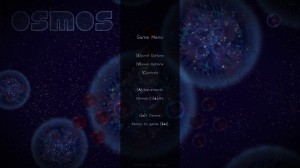There are days where you just want to hang up your Batsuit, holster your Portal Gun, and take a break from fighting off never-ending waves of zombies, robots, or whatever antagonist you happen to be currently transfixed on at the time. Sometimes you just want to put your feet up and enjoy a game that delivers relaxing ambience while providing enough of a challenge to keep you playing for long stretches. In times like that, Osmos is just what the doctor ordered. Osmos is a game that tasks you with controlling a mote (a single-celled organism) whose goal is to grow by absorbing other motes. Before we taking a look at the game in further detail, I’d like to thank Eddy Boxerman from Hemisphere Games for sending me a free review copy.
When you load up Osmos, you’ll be presented with a few different options. The center of the screen will display the levels you’ll be able to play while the top right corner of the screen will give you access to your menu options. While there isn’t a way to change the screen resolution, you can toggle fullscreen on and off. The controls aren’t rebindable within this menu, but are simple enough to where you won’t need to memorize a whole bunch of different keystrokes.
Editor’s Note: I’m told that you can enter windowed mode, then resize the window manually to change the resolution.
The general idea of Osmos is simple: avoid motes larger than your own. You can grow your mote by absorbing motes smaller than your own. Those who have played the various flash games on the web (Fish Tales, Fish Eat Fish, etc.) that put you in the role of a fish trying to climb your way to the top of the food chain will be able to jump right in. To assist the player, the motes change color to indicate whether or not they are ripe for absorbing. Motes that are blue are smaller than your own, while motes that are red will absorb you if you touch them. Grazing a larger mote doesn’t mean instant death, but some of your mote will leech off into the larger mote, making you smaller. Eventually, you’ll learn how to speed up and slow down time, which can be extremely helpful in certain situations.
Movement isn’t just a matter of pointing your mouse somewhere and clicking a button. Moving involves putting your cursor behind the mote and clicking so that it travels in the opposite direction, as if you were giving it a good kick in the pants. Clicking multiple times will increase the force and speed in which it travels in that direction as will holding the mouse button in. The kicker is however that as you apply force to move, you’ll lose mass. Smaller motes will be expelled behind you every time you click that mouse, making you grow smaller. Traversing the world of Osmos not only requires patience and logic, but a little finesse.
With the above game mechanics in mind, you’ll make your way from level to level, trying to grow your mote and avoid being absorbed by the larger ones. Levels themselves task you with a few different things, but the overall goal is roughly the same…get bigger. “Ambient” levels come in a variety of different flavors…the earlier levels might just plop you around a bunch of inactive motes while later levels add different things like antimatter that will annihilate matter when they collide. “Force” levels adds gravitational pull to the equation, causing all of the motes to orbit the attractor. You’ll be able to change your orbit by applying thrust in different directions. Personally, these were my favorite types of levels seeing as how I enjoy astronomy and all things related, including the physics that accompany celestial bodies. “Sentient” levels involve other motes that are active in some manner and respond to their surroundings in different ways. Some actively move away from larger motes as they approach, for example.

Orbits are a lot of fun to mess around with. A few simple thrusts can make the difference between being the absorber and the absorbed.
The game boasts forty-seven different levels to wrap your head around, though the level progression is such that you won’t be overwhelmed from the get-go. You can replay levels you’ve defeated and even randomize the starting locations of all of the motes, adding quite a bit of replayability. When you come across a level you like and wish to replay it a few hundred times (as I am often want to do) you’ll be presented with new layout each time to keep things interesting. I find this feature to be a great addition to the game as I don’t like being tied down to the same linear level each and every time…eventually you get so good at it that you lose interest.

Failure isn’t always a bad thing…though you can randomize the level by simply hitting “Alt-Z” if you get stuck.
Overall, I found Osmos to be a fantastic way to unwind after a tough day at the office. Its overall ambience, accompanied by an excellent soundtrack, will keep your mood relaxed while the various puzzles keep your mind engaged. It’s something that you can come back to, play as little or as much of as you want, and call it a day as there are no storylines and plot twists to keep track of. As both a parent and an accountant who maintains a busy schedule, games like this rank up there on my list for obvious reasons. In my opinion, it’s well worth its current price tag of $9.99 on Steam (as of 10/21/12).
Final Verdict: 8/10
—
You can learn more about “Osmos” by checking out the following website:
http://www.hemispheregames.com/osmos/
You can find the game on Steam, here:
http://store.steampowered.com/app/29180/
You can view play sessions here:
http://www.youtube.com/watch?v=ZfQ3qULNUjM






